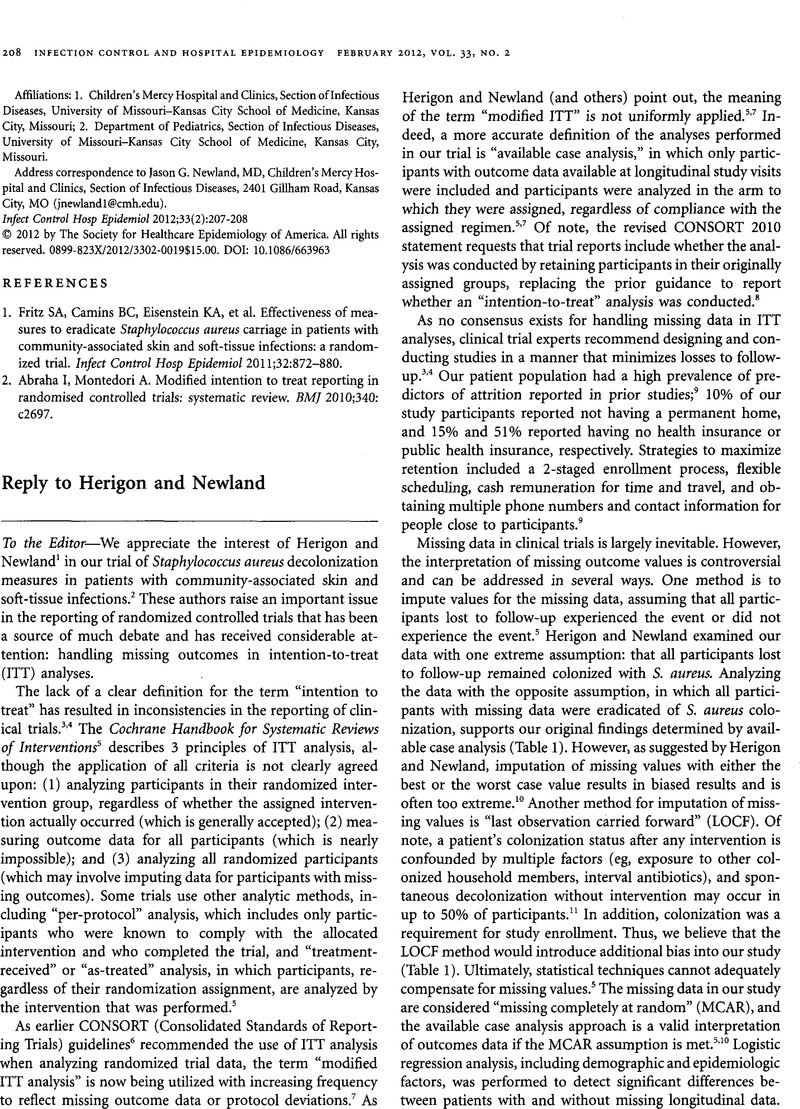No CrossRef data available.
Article contents
Reply to Herigon and Newland
Published online by Cambridge University Press: 02 January 2015
Abstract
An abstract is not available for this content so a preview has been provided. As you have access to this content, a full PDF is available via the ‘Save PDF’ action button.

- Type
- Letters to the Editor
- Information
- Copyright
- Copyright © The Society for Healthcare Epidemiology of America 2012
References
1.Herigon, JC, Newland, JG. The role of intention-to-treat analyses in randomized trials. Infect Control Hosp Epidemiol 2012;33:207–208 (in this issue).Google Scholar
2.Fritz, SA, Camins, BC, Eisenstein, KA, et al. Effectiveness of measures to eradicate Staphylococcus aureus carriage in patients with community-associated skin and soft-tissue infections: a randomized trial. Infect Control Hosp Epidemiol 2011;32:872–880.Google Scholar
3.Altman, DG. Missing outcomes in randomized trials: addressing the dilemma. Open Med 2009;3:e51–e53.Google Scholar
4.Hollis, S, Campbell, F. What is meant by intention to treat analysis? survey of published randomised controlled trials. BMJ 1999;319:670–674.Google Scholar
5.Higgens, JPT, Green, S. Cochrane Handbook for Systematic Reviews of Interventions: Version 5.1.0 [updated March 2011]. http://www.cochrane-handbook.org. Published 2011. Accessed November 1, 2011.Google Scholar
6.Moher, D, Schulz, KF, Altman, D. The CONSORT statement: revised recommendations for improving the quality of reports of parallel-group randomized trials. JAMA 2001;285:1987–1991.Google Scholar
7.Abraha, I, Montedori, A. Modified intention to treat reporting in randomised controlled trials: systematic review. BMJ 2010;340:c2697.CrossRefGoogle ScholarPubMed
8.Schulz, KF, Altman, DG, Moher, D. CONSORT 2010 statement: updated guidelines for reporting parallel group randomized trials. Ann Intern Med 2010;152:726–732.CrossRefGoogle ScholarPubMed
9.Hessol, NA, Schneider, M, Greenblatt, RM, et al. Retention of women enrolled in a prospective study of human immunodeficiency virus infection: impact of race, unstable housing, and use of human immunodeficiency virus therapy. Am J Epidemiol 2001;154:563–573.Google Scholar
10.Wood, AM, White, IR, Thompson, SG. Are missing outcome data adequately handled? a review of published randomized controlled trials in major medical journals. Clin Trials 2004;1:368–376.Google Scholar
11.Ellis, MW, Hospenthal, DR, Dooley, DP, Gray, PJ, Murray, CK. Natural history of community-acquired methicillin-resistant Staphylococcus aureus colonization and infection in soldiers. Clin Infect Dis 2004;39:971–979.Google Scholar
12.Mallory, C, Miles, MS, Holditch-Davis, D. Reciprocity and retaining African-American women with HIV in research. Appl Nurs Res 2002;15:35–41.CrossRefGoogle ScholarPubMed


